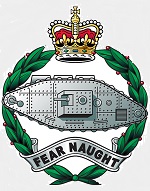Hobby Master HG3511 British Centurion Mk.3 Main Battle Tank - "Columbo", 8th Hussars Regiment, Korea, 1951 (1:72 Scale)
"Pristinae virtutis memores."
- Motto of the 8th Hussars Regiment
 The Centurion was Britain's first attempt to produce a universal tank and do away with divisions between the infantry tanks, such as the Matilda, and cruiser tanks like the Comet. In 1943, after a succession of unfortunate tank designs, the British War Office commissioned a new specification calling for a tank weighing 40-tons that offered durability, reliability, and the ability to withstand a direct hit from a German 88mm gun. Six prototypes were developed before the end of World War II, all of which arrived too late to take part in the war.
The Centurion was Britain's first attempt to produce a universal tank and do away with divisions between the infantry tanks, such as the Matilda, and cruiser tanks like the Comet. In 1943, after a succession of unfortunate tank designs, the British War Office commissioned a new specification calling for a tank weighing 40-tons that offered durability, reliability, and the ability to withstand a direct hit from a German 88mm gun. Six prototypes were developed before the end of World War II, all of which arrived too late to take part in the war.
It was soon recognized that the weight restrictions had to be lifted as the original specification could not be achieved within the 40-ton weight limitation. The early vehicles were equipped with a 17 pounder main gun and a 20mm Polsten cannon. They also featured frontal, glacis plate armour to deflect shots, a partially cast turret and a Horstmann suspension. However, modifications to the original design were quickly made and the changes resulted in the adoption of a 20 pounder, fully stabilized main gun and the replacement of the 20mm cannon with a Besa machine gun (thus allowing the turret to be fully cast). These changes resulted in the Mk IV version of the vehicle.
In order to maintain its combat effectiveness, continuing modifications have led to numerous other changes to the main gun armament (most notably the incorporation of a 105mm gun), the addition of fire control equipment and infra-red driving aids, a new diesel engine, and a semi-automatic transmission.
The Centurion first saw action in Korea during 1951 and soon proved itself to be the best performing tank in this theatre of operations, offering excellent cross country performance. It has also been exported to a number of client nations, particularly Israel, which used them with great effect in several of the Arab-Israeli Wars.
Pictured here is a 1:72 scale replica of a Centurion Mk.3 battle tank that was nicknamed "Columbo", and attached to the 8th Hussars Regiment, then deployed to Korea during 1951.
Sold Out!
Dimensions:
Length: 4-inches
Width: 1-1/2-inches
Release Date: May 2013
 Historical Account: "Once Dragoons" - The 8th King's Royal Irish Hussars was a cavalry regiment in the British Army, first raised in 1693. It saw service for three centuries, before being amalgamated into The Queen's Royal Irish Hussars in 1958. The regiment was first raised in Ireland as Henry Conyngham's Regiment of Dragoons in Derry in 1693, and ranked as the 8th Dragoons. It was briefly disbanded from 1714 to 1715, and 1716 to 1719, reforming each time without any loss of precedence. In 1751, it was formally titled as the 8th Regiment of Dragoons, and designated light dragoons in 1775 as the 8th Regiment of Light Dragoons.
Historical Account: "Once Dragoons" - The 8th King's Royal Irish Hussars was a cavalry regiment in the British Army, first raised in 1693. It saw service for three centuries, before being amalgamated into The Queen's Royal Irish Hussars in 1958. The regiment was first raised in Ireland as Henry Conyngham's Regiment of Dragoons in Derry in 1693, and ranked as the 8th Dragoons. It was briefly disbanded from 1714 to 1715, and 1716 to 1719, reforming each time without any loss of precedence. In 1751, it was formally titled as the 8th Regiment of Dragoons, and designated light dragoons in 1775 as the 8th Regiment of Light Dragoons.
The regiment was renamed in 1777 for George III as the 8th (The King's Royal Irish) Regiment of (Light) Dragoons, and became hussars in 1822, as the 8th (The King's Royal Irish) Regiment of (Light) Dragoons (Hussars). The title was simplified in 1861 to the 8th (The King's Royal Irish) Hussars. After service in the First World War, the regiment retitled as the 8th King's Royal Irish Hussars in 1921, and was transferred to the Royal Armoured Corps in 1939. Fighting with distinction in North Africa, Greece, France & Germany during World War II. The regiment survived the immediate post-war reduction in forces, and went on to distinguish itself in the battles of the Korean War, but was recommended for amalgamation in the 1957 Defence White Paper prepared by Duncan Sandys. The regiment was amalgamated with the 4th Queen's Own Hussars, to form the The Queen's Royal Irish Hussars the following year.


